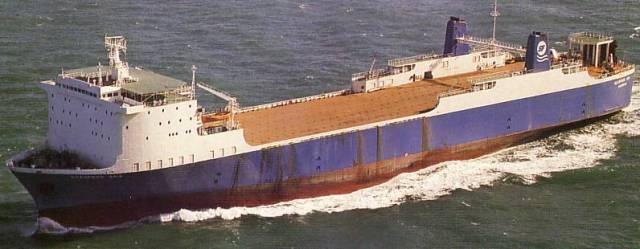Update January 3, 2014 – 10:15 AM
Treatment of Syrian chemical substances onboard the American ship Cape Ray is a default solution. It follows Northern European countries’ refusal to directly dispose of the precursor chemical ammunition in specialized facilities (*). This operation on the high seas would install industrialization of the world’s oceans.
In 2006 a few kilometers off the coast of Gibraltar, in international waters, refining activities had already been carried out onboard the tanker Probo Koala. Following these operations 500t of toxic sludge was released from the Probo Koala in Ivory Coast. Projects of Floating Nuclear Power Plants, of wind farms and current turbines are accumulating. No international Convention, no rules or IMO regulations (International Maritime Organization) ban industrial activities in international waters except if it deteriorates the quality of territorial waters or the environment in neighboring countries. To date, the only industrial activity banned on the world’s ocean is incineration at sea (**).
 Seaspeed Asia, now Cape Ray, in 1981 – Nils Jonas Saetre: capture by Robin des Bois
Seaspeed Asia, now Cape Ray, in 1981 – Nils Jonas Saetre: capture by Robin des Bois
The Cape Ray (ex Saudi Makkah, ex Seaspeed Asia) is a Ro-Ro (Roll-on/Roll-off) built to transport trailers and other vehicles. It was bought by the United States Maritime Administration (MARAD) in 1991 joining the reserve fleet with 31 other Ro-Ros to ensure the transport of military equipment and supplies. This type of ship is particularly vulnerable to fires and to ingress water; a Ro-Ro lists in minutes and quickly sinks with its cargo (all of the chemical waste to be treated will be onboard the Cape Ray). Built to be like a floating parking lot, it doesn’t have transverse bulkheads that would prevent water or fire spreading. The Cape Ray is strengthened for navigation in icy waters yet has a single hull. The amenities carried out over the last weeks will not guarantee sufficient floating capacity in case of serious structural damage. The Cape Ray was built 36 years ago. All ships even those repainted and re-fitted still bear the age of their metal. On average, a Ro-Ro is broken up after 30 years service. The Danish and Norwegian ships designated to transport the priority chemical part of the Syrian arsenal from Latakia port to the Italian port where the Cape Ray will be loaded should, logically, be double hull yet all logic seems to be shaken up. One of the ships is the Taiko, another Ro Ro built in 1984 owned by Wilhelmsen Lines well known in the North Sea notably for the wreck of the Tricolor in 2002.
The Field Deployable Hydrolysis System (FDHS) for pretreatment of weapon chemical substances developed by the US Department of Defense in collaboration with the industrial sector is a pilot project. Development was finalized this summer. The system’s ability to continually and securely treat 500 to 600 tons of toxic substances is yet to be proven. It was built to be used on land. To be used for the first time on an industrial scale onboard a ship is an adventurous operation with multiple risks for the crew, the technicians and the environment. An aerial and maritime exclusion area around the Cape Ray will be possible but nothing can prevent bad weather, storms or other sea events potentially reducing the safety of handling, stability and reliability of the equipment and process. The Cape Ray will most probably be stationed on international waters. In the Mediterranean, save for some exceptions they start from between 6 and 12 miles from the coast (11 and 22 km), notably along the Italian coast.
The FDHS is a pretreatment that produces waste. The provisional total is 800 tons of sludge for the 500 to 600 tons of chemical waste to be treated. The final elimination methods and location of the sludge is yet to be decided all the more that characterization as presented by the OPCW (Organization for the Prohibition of Chemical Weapons) is imprecise. To the 800 tons of sludge must be added 4000 contaminated drums, personal protective equipment, rags and cleanup materials, spill pillows, carbon filters and HEPA filters. The last two waste items show that atmospheric emissions are expected during the process.
Regarding the legal aspect, one of the questionable points is non-application of the Basel Convention on the Control of Transboundary Movements of Hazardous Wastes and their Disposal. Syria ratified this Convention in 1992, the United States has not. The chemical products to be destroyed are classified waste. For exportation from Syria towards the Cape Ray, under United States rule, to be legal a specific agreement between the exporting State and the receiving State must be established (Articles 4 and 11 of the Basel Convention). It also raises questions concerning authorization for transit in countries of transshipment and in their territorial waters, except if this offload takes place in an US military enclave.
(*) To be noted the United Kingdom has just authorized treatment of 150 tons on their soil.
(**) The International Maritime Organisation pointed out to Robin des Bois the fact that from January 1st 2014 the physical blending of bulk liquid cargoes on board ships during sea voyages with the intent to achieve a cargo with a new product designation is prohibited. It covers, for example, the refining of hydrocarbons which took place on board the Probo Koala in 2006. Robin des Bois welcomes this new regulation and wished for its implementation to avoid the repetition and the diversification of industrial activities on board ships.
The application of this new regulation to the operations of the pre-treatment and the processing of priority substances included in the composition of Syrian chemical weapons on board the Cape Ray or another vessel is open to multiple interpretations in particular from the flag State and neighbouring States. Update January 3, 2014 – 10:15 AM
 Imprimer cet article
Imprimer cet article









